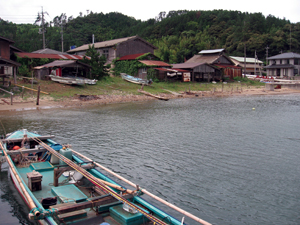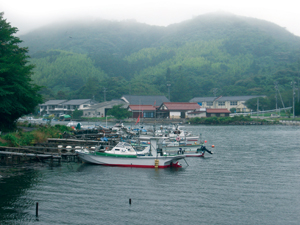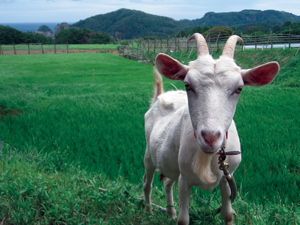Okinoshima 隠岐の島
|
There are idyllic islands aplenty in Japan: Okinawa with its sun-kissed beaches, Niijima and its playful surf, Miyajima’s unspoiled forests above the shrine, Sado with its tub-boats and demon drums. But if you truly want to get away from it all, we suggest you loosen your gait, let down your hair, and head to Okinoshima. The Oki archipelago off the coast of Shimane Prefecture comprises 184 islands in total, only four of which are inhabited: Dogo, Nishinoshima, Chiburishima and Nakanoshima. In the twelfth and fourteenth centuries, two emperors, Go-Toba and Go-Daigo respectively, were banished to this remote place. Were the same to happen today, it might seem an act of kindness, not a punishment. Despite their historical association with exile, today the Oki islands are anything but inhospitable. Passing motorists roll down their windows to ask roadside hikers if they need assistance, ramen shop chefs wax on happily about the islands’ history, rice farmers wave from their fields, and squid boat captains gladly explain the workings of their lamps, whose incandescent light attracts their tentacled prey to the surface for easy capture. Oki islanders are justly proud of their seafood, which in addition to squid also includes oysters, crabs, and chewy but delicious turban shellfish.
There is a modest collection of temples and shrines on the islands, including the Tamawakasu Shrine on Dogo, which boasts unique Oki-style architecture and a beautiful millennium-old cedar tree. There is also a scattering of faded and forlorn historical sites. A small monument marking the site of Go-Daigo’s imperial palace, for example, is just a short stroll from the Beppu ferry dock. Frankly, travelers to Oki come not for the history but for the scenery: gorgeous seaside vistas are the real draw here. Among the highlights on Dogo are the white cliffs of the Shirashima seashore and the surreally beautiful rock islets at Jyoudogaura. The sunsets at Candle Rock, Cape Nagu, and Shionohama are flat-out spectacular in any season. On Nishinoshima, the hiker-friendly Kuniga coastline is a stunner: morning mists part to reveal jaw-dropping views of towering cliffs and filigree rock formations. The Matengai lookout offers westward ocean views from atop the tallest sea cliff in Japan (257m), while horses and bulls graze on the lush greenery. Bulls are ubiquitous in Oki, where the unique cultural traditions include bullfighting (bull vs. bull) competitions during the summer months. Nara and Heian-era dance performances take place in April, and a cooperative festival between a sun shrine and a moon shrine is held during October of odd-numbered years. Although rental car services and taxi-based tours are available in Oki, the islands offer far greater visual rewards to hikers who can traverse cliffs and coastal areas beyond the roads. More active visitors can indulge in wakeboarding, windsurfing, sailing, and diving, especially around Nishinoshima. The ferry terminals in both Dogo and Dozen have a wealth of English-language brochures and helpful staff who can offer sightseeing suggestions and help you sort out your accommodation. (For travelers to Nishinoshima, I recommend the friendly Takenami Minshuku, just a short walk down the road from Beppu harbor. Rates are about ¥7,000 per night per person and include two meals.) Meal service outside the hotels and minshuku is limited, since local cafes and restaurants are open only a few hours each day and only near the major ports. Access to Oki is via plane (flights depart from Izumo and Osaka airports) or a 2.5-hour ferry ride from Sakaiminato or Shichirui on the Shimane peninsula. Note that the rough seas around Oki can affect the frequency of ferry services, particularly during the stormy winter months, so leave some leeway in your schedule for possible delays. www.town.okinoshima.shimane.jp(Japanese) |
日本には魅力的な島があちこちにある。南国を実感できるビーチが魅力的な沖縄、サーファーなどにはいい波が期待できる新島、厳島神社や美しい原始林で知られる宮島、たらい舟と鬼太鼓で有名な佐渡島・・・ でも煩わしいことから解放されて本当にゆっくりしたいと思ったら隠岐の島へ行こう。 島根半島沖の日本海に浮かぶ隠岐諸島は大小合わせて184の島々からなり、そのうち人が住んでいるのは島後(どうご)、西ノ島、知夫里島、中ノ島(島後に対してこの3つの島を合わせて島前と呼ぶ)。13世紀には後鳥羽上皇、14世紀には後醍醐天皇がこの地に島流しとなった。しかし、かつての流刑の地も今では素敵なリゾート地、今ならむしろ島流しされたいくらいだ。道行く車のドライバーは皆親切に声を掛けてくるし、たまたま入ったラーメン屋の主人は島の歴史について教えてくれる。農家の人たちは田んぼから手を振ってあいさつしてくるし、イカ釣り船の船長は船にたくさん付いている明るい灯火にイカが集まってくる様子などいろいろ話してくれる。隠岐の海の幸はイカの他、牡蠣、カニ、そしてサザエもたくさん獲れる。 島後にある玉若酢命神社はこの地方独特の隠岐造による国の重要文化財で、境内の樹齢千年を超える杉の木も美しい。その他、廃れゆく歴史的遺物が島内には点在、西ノ島の別府港近くには後醍醐天皇の行在所を示す遺跡などもある。 実際には隠岐を歴史探訪目的で訪れる観光客は少なく、そのひたすら美しい海を満喫するために訪れる人がほとんどだ。島後の代表的な景勝地としては白い岩石が美しい白島海岸や山水画のような美しさが自慢の浄土ヶ浦など。ローソク岩、那久岬、塩浜などから見る夕陽は一年を通して楽しめる絶景だ。西ノ島に渡ると、最高のハイキングを楽しめる国賀海岸の風景がとにかく圧巻。海蝕崖では日本一の高さ(257m)を誇る磨天崖のスケールの大きさには言葉を失う。また国賀海岸一帯の断崖絶壁を臨む牧草地帯には馬や牛が放牧されていて、雄大な自然景観を作り出している。 牛突き(隠岐では闘牛とは言わない)も盛んで夏季にあちこちで開催される。毎年4月には奈良・平安時代の舞踊を再現した催事が行われ、隔年の10月に行われる「隠岐武良祭風流」(おきむらまつりふうりゅう)は日天子を祀る神社と月天子を祀る神社が合同で行う由緒ある伝統行事。 レンタカーやタクシーでの観光地巡りもいいが、ハイキングのほうがじっくりと美しい景色を味わえる。また、ウェークボードやウィンドサーフィン、セーリングボート、ダイビングなどを楽しむなら特に西ノ島周辺がお勧めだ。 島前や島後のフェリー乗り場には英語のガイダンスが置いてあるし、親切なスタッフが宿泊や観光に関するアドバイスもしてくれるので助かる。西ノ島観光の拠点には別府港に着いてすぐの「竹並旅館」が個人的にお勧め。一泊二食付きで7000円前後。旅館や民宿以外で飲食できる店は港周辺に限られているうえ、多くは昼間の何時間かしか営業していないので注意が必要。 隠岐の島へのアクセスは、出雲空港か大阪伊丹空港から飛行機で、あるいは境港か七類港からフェリーで2時間半、高速船レインボーなら60分。船便は冬場を中心に時化のため欠航することがあるので注意が必要。旅程には余裕を持って。 www.town.okinoshima.shimane.jp
|











